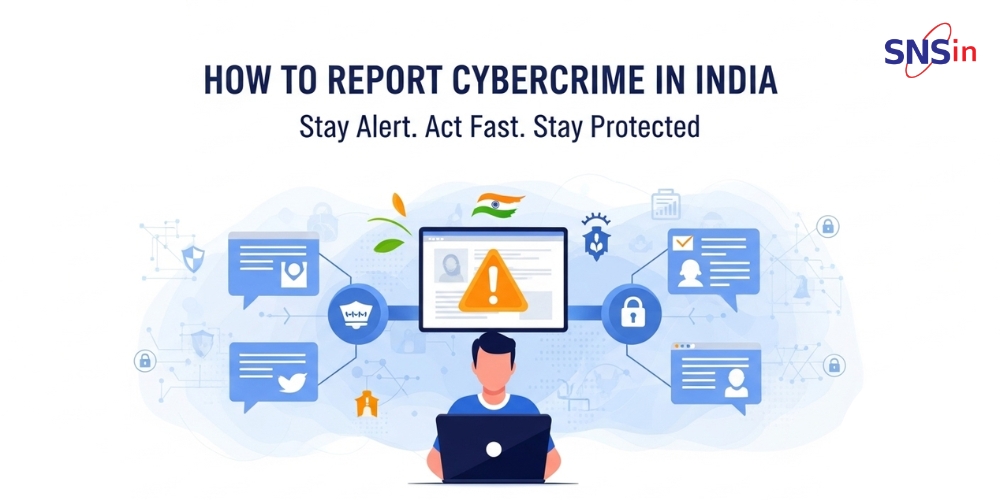Imagine this:
You wake up, sip your morning chai, check your phone — and bam! Your bank app says you just spent ₹40,000 on a gadget you’ve never even Googled. Or maybe your business email gets hacked, and your client receives a fake invoice with your name on it. Or worse, you stumble across your private photos on a random website.
Welcome to the dark alleys of the internet — where cybercrime doesn’t knock, it slides in silently.
But here’s the good news: You don’t have to feel helpless. In 2025, India has a robust and increasingly digitized process for reporting cybercrimes. Whether you’re an individual or a B2B firm, this guide will walk you through “what, where, and how” of filing a cybercrime complaint — clearly, quickly, and with a little storytelling flair.
First Things First: What Counts as Cybercrime?:
Let’s clear the air. Cybercrime is not just hacking. It covers a vast range of offenses, such as:
- Financial fraud (UPI, credit card, banking scams)
- Identity theft
- Business email compromise
- Online harassment, stalking, or bullying
- Data breaches & ransomware attacks
- Social media impersonation
- Revenge porn or non-consensual explicit content
- Deepfake manipulation
- Cyberterrorism
In 2023 alone, India recorded over 1.6 million cybercrime complaints, a massive jump from just 208,000 in 2018. Source: NCRB & Indian Cybercrime Coordination Centre (I4C).
Cybercrime doesn’t care whether you’re tech-savvy or not. It only needs one weak password or one careless click.
Step-by-Step Guide to Reporting Cybercrime in India:
Now, let’s break it down like a recipe. Only instead of biryani, we’re cooking up justice.
Step 1: Act Fast and Stay Calm:
The moment you realize you’re a victim, don’t wait. Cybercriminals move quickly, and delay = damage.
- Don’t delete evidence (screenshots, emails, messages)
- Immediately change passwords to all sensitive accounts
- If money is involved, notify your bank ASAP and request a freeze
Step 2: Know Where to File:
There are two main channels to report cybercrimes in India:
1. The National Cybercrime Reporting Portal:
https://www.cybercrime.gov.in/
Run by the Ministry of Home Affairs, this portal is your primary destination for most cyber-related complaints. It’s user-friendly, mobile-friendly, and supports complaints in multiple Indian languages.
2. Local Police Station or Cyber Cell:
You can also file a First Information Report (FIR) at your nearest police station or cyber cell. Cybercrime has no jurisdiction limits, meaning you can report it from anywhere — even if the crime happened in another state.
Pro Tip: If the local police hesitate (which still happens, sadly), politely remind them of Section 154 of the CrPC (Criminal Procedure Court), which mandates registering an FIR for cognizable offenses.
Step 3: Filing on the National Portal (Cybercrime.gov.in):
Let’s walk through it like you’re doing it right now:
Step A: Register as a Complainant:
- Visit gov.in
- Click on “File a Complaint”
- Choose either:
- Women/Child related crimes OR
- Other cyber crimes
Step B: Fill Out the Complaint Form:
Provide the following:
- Personal details (name, contact, email)
- Incident details (date/time, nature of crime)
- Platform used (Facebook, WhatsApp, UPI, etc.)
- Upload screenshots, chat logs, transaction IDs, or emails
Be accurate and detailed, but don’t panic if you don’t know the techy stuff. Just explain what happened in your own words.
Step 4: Keep the Reference Number Safe:
Once submitted, the portal gives you a complaint reference number (e.g., CCN2025XXXX). Keep this safe — it’s your digital receipt.
You can use it to:
- Track status updates on the portal
- Submit additional documents later
- Follow up with law enforcement
Step 5: Escalate if Needed:
If you feel your complaint isn’t being taken seriously, or if the local police refuse to register your FIR:
- Write to the District Cyber Crime Cell Nodal Officer (every state has one — list is on the portal)
- File an email grievance to [email protected]
- Approach a lawyer to file a writ petition under Article 226 in the High Court, if your rights are violated
Remember, you have the right to be heard.
What You’ll Need: Evidence Checklist:
The more evidence you provide, the stronger your case. Keep ready:
- Screenshots of chats, emails, social media posts
- Bank or transaction records (UTR numbers, timestamps)
- URLs of fraudulent websites or profiles
- Call logs or phone numbers
- Details of any suspicious links clicked
For B2B Firms: Reporting as an Organization:
If you’re a business dealing with:
- Phishing attacks
- Ransomware incidents
- Customer data leaks
- Insider threats
Here’s your tailored playbook:
- Alert your internal incident response team
- Notify the CERT-In (Indian Computer Emergency Response Team):
📧 [email protected]
https://www.cert-in.org.in
- File the incident with cybercrime.gov.in
- Alert partners/customers if their data is affected (transparency = trust)
- Prepare to comply with the Digital Personal Data Protection Act, 2023
Failure to report a cyber incident can now attract fines under DPDP rules, especially if customer data is involved.
Cyber Helplines: Always On, Always Listening:
India’s cybercrime helpline is: 1930
(Available 24×7 in most states for reporting financial frauds like UPI scams, wallet hacks, or fake QR codes.)
The sooner you call, the higher the chances of stopping or reversing a transaction.
Real Talk: Why Reporting Matters:
You might think, “It’s just ₹5,000” or “My account was recovered, so no big deal.” But here’s the thing:
Only 1 in 10 cybercrimes get reported in India.
Underreporting:
- Let’s fraudsters walk free
- Delays policy improvements
- Undermines cybersecurity awareness
Your report = your power.
Final Thoughts: Click Safe, Report Smart:
In today’s connected world, being targeted online is not your fault. But staying silent only helps the criminals.
Whether you’re an entrepreneur whose email got hijacked, a teenager dealing with online bullying, or a CXO navigating a ransomware attack — you’re not alone.
Cybercrime is a battle. Reporting is your sword.
About SNS India:
We have been protecting organizations against cyber threats for last 25 years. In case your need consultancy you can hire our services for expert advise and peace of mind.
Enquire now at [email protected].
Stay aware. Stay alert. Stay protected.
![]()




